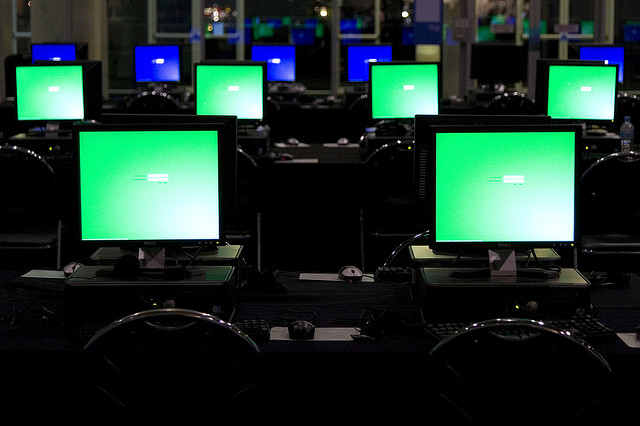Children’s eSafety Commissioner steps up to safeguard children online
Posted By Clare Murphy on July 9, 2015 @ 11:00
 [1]
[1]ASPI’s recent report, Gen Y Jihadists: Preventing Radicalisation in Australia [2], recommends engaging schools in a practical discussion about Middle Eastern politics, terrorism and counter-radicalisation. This follows news that the federal government is considering a deradicalisation strategy in schools [3], where teachers receive training to recognise behaviour amongst students that could potentially indicate a propensity towards extremism.
So it’s timely that the former director of the Australian Federal Police’s High Tech Crime Centre, Alastair MacGibbon, has stepped into the newly-created role of Children’s eSafety Commissioner. This Commissioner’s independent statutory Office [4] will sit within the Australian Media and Communications Authority [5] and answer to the Minister for Communications.
As Anthony Bergin and I explained in The Financial Review [6], this role is the first of its kind worldwide. The Office will administer complaints [7] based on a two-tiered system of social media services. Tier one status is dependent on application by a service and the Commissioner being satisfied that it meets basic online safety requirements. Tier two status is determined by the Minister for Communications after the Commissioner has deemed the service to meet the criteria of a large social media service.
The Commissioner can take enforceable action against a tier two service, but not a tier one; here he can only request removal of material. So the Commissioner has powers to compel certain social media services to take down material that’s deemed to be harassing an Australian child. If the service doesn’t comply within 48 hours, they risk fines of $17,000 per day [8].
But another important task is intervening in cases of young people being targeted by online extremists. That’s a significant challenge, given an estimated 90% of Australians aged 12 to 17 use some form of social media [9]. What’s worrying is that teachers often don’t know how best to intervene when they identify students demonstrating extremist views [10].
The Office aims to change the culture surrounding online behaviour [11]. Failing to acknowledge the role of social media in the lives of young Australians is potentially dangerous and MacGibbon wants 21st century kids to become ‘resilient digital citizens’ [12]. While it might be difficult to protect every student, ‘herd inoculation’ might be a way to encourage young people to behave safely and responsibly online.
The government’s community resilience to violent extremism initiative, Living Safe Together [13], outlines the four tiers of the government’s strategy to counter violent extremism (CVE), one of which is challenging extremist propaganda. However Living Safe Together doesn’t refer to the Office of the Children’s eSafety Commissioner, despite having its own Report Online Extremism Material mechanism. CVE measures could be maximised by drawing various government resources together.
The Office isn’t the only organisation promoting cyber safety in schools. I recently met with Oscar Yildiz who is the Executive Director of BullyZero [14], a program which conducts information sessions for students and teachers on online hazards, including extremist propaganda.
He explained that while he initially met some resistance from parts of the community, demand from schools is increasing as word spreads. He explained that younger students were more forthcoming in telling adults if they’ve been targeted by extremists online, whereas older students are often more reticent due to embarrassment. Perhaps this highlights the need to provide older students with trusted individuals to approach. However, the program receives no government funding and instead relies on fundraising and volunteers.
BullyZero is one of several community organisations educating students about online harms. There’s merit in using non-government organisations here as it’s better to have more than one message for students to choose from. So community organisations who are working on cyber safety might be worthy recipients of some of the $22 million the government has allocated to CVE [15]in the recent federal budget.
The Office of the eSafety Commissioner presents an opportunity for positive change in online safety, and it’s promising to see the government countering online extremism more effectively. But it’s important that these efforts take whole-of-government and societal approaches on board. Collaboration across federal and state governmental departments would maximise resources, and this new eSafety function presents an opportunity for oversight of online safety initiatives. At the same time, community engagement to leverage community capabilities may ensure that all relevant players across state and society are equipped to keep young Australians safe online.
Article printed from The Strategist: https://www.aspistrategist.org.au
URL to article: https://www.aspistrategist.org.au/childrens-esafety-commissioner-steps-up-to-safeguard-children-online/
URLs in this post:
[1] Image: http://www.aspistrategist.org.au/wp-content/uploads/2015/07/225171152_e9a4c4e219_z.jpg
[2] Gen Y Jihadists: Preventing Radicalisation in Australia: https://www.aspi.org.au/publications/gen-y-jihadists-preventing-radicalisation-in-australia/GenY_jihadists.pdf
[3] considering a deradicalisation strategy in schools: http://www.heraldsun.com.au/news/victoria/students-teachers-to-learn-how-to-spot-potential-jihadis-under-officials-plans/story-fnpp4dl6-1227366800928
[4] independent statutory Office: https://esafety.gov.au/
[5] Australian Media and Communications Authority: http://www.acma.gov.au/
[6] The Financial Review: http://www.afr.com/opinion/columns/new-esafety-cop-will-pound-internet-beat-20150705-gi5dth
[7] Office will administer complaints: https://esafety.gov.au/complaints-and-reporting/offensive-and-illegal-content-complaints/lodge-an-offensive-or-illegal-content-complaint
[8] risk fines of $17,000 per day: http://www.abc.net.au/news/2015-03-19/childrens-e-safety-commissioner-to-fine-social-media-sites/6332854
[9] estimated 90% of Australians aged 12 to 17 use some form of social media: http://www.acma.gov.au/webwr/aba/about/recruitment/click_and_connect-02_quantitative_report.pdf
[10] teachers often don’t know how best to intervene when they identify students demonstrating extremist views: http://www.theaustralian.com.au/news/features/counter-radicalisation-helping-kids-to-resist-islamic-state-allure/story-e6frg6z6-1227427584798
[11] change the culture surrounding online behaviour: http://www.abc.net.au/am/content/2015/s4265044.htm
[12] ‘resilient digital citizens’: http://www.2dayfm.com.au/news/feed/2015/6/extra-help-for-cyberbullying-victims-/
[13] Living Safe Together: http://www.livingsafetogether.gov.au/pages/home.aspx
[14] BullyZero: http://bzaf.org.au/
[15] $22 million the government has allocated to CVE : http://budget.gov.au/2015-16/content/highlights/nationalsecurity.html
Click here to print.